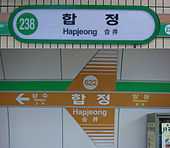Hapjeong Station
From Wikipedia, the free encyclopedia
| Hapjeong Station | |||||
|---|---|---|---|---|---|
 Hapjeong Station | |||||
| Korean name | |||||
| Hangul | 합정역 | ||||
| Hanja | 合井驛 | ||||
| Revised Romanization | Hapjeong-yeok | ||||
| McCune–Reischauer | Hapchŏng-yŏk | ||||
| Railway Services | |||||
| Daily ridership |
Based on Jan-Dec of 2012. Line 2: 53,987[1] Line 6: 19,349[1] | ||||
| |||||
| Station number | 238 | ||||
| Address |
393 Seogyo-dong, Mapo-gu, Seoul | ||||
| Date opened | May 22, 1984 | ||||
| Type | Underground | ||||
| Platforms/tracks | 2 / 2 | ||||
| Operator | Seoul Metro | ||||
| |||||
| Station number | 622 | ||||
| Address |
414 Hapjeong-dong, Mapo-gu, Seoul | ||||
| Date opened | December 15, 2000 | ||||
| Type | Underground | ||||
| Platforms/tracks | 2 / 2 | ||||
| Operator | SMRT | ||||
Hapjeong Station is a subterranean station of Seoul Subway Line 2 and Seoul Subway Line 6. The station is located just north of the Han River in Mapo-gu.
The station is the southern end of Hongdae area, which is the mecca of urban arts and indie music culture of Seoul. It is closest to the historical site of Jeoldu-san, a place where over 10,000 Koreans of the Roman Catholic faith were beheaded in 1866 under the orders of Daewon-gun. Yanghwajin Foreigners' Cemetery and the Holt International Children's Services are also located near the station. The northern end of Yanghwa Bridge is near the gates of the station.
References
- ↑ 1.0 1.1 Monthly Number of Passengers between Subway Stations. Korea Transportation Database, 2013. Retrieved 2013-10-15.
| Wikimedia Commons has media related to Hapjeong Station. |
| Preceding station | Seoul Metropolitan Subway | Following station | ||
|---|---|---|---|---|
toward City Hall |
Line 2 | toward Chungjeongno |
||
toward Eungam |
Line 6 | toward Bonghwasan |
Coordinates: 37°32′57″N 126°54′49″E / 37.54917°N 126.91361°E
This article is issued from Wikipedia. The text is available under the Creative Commons Attribution/Share Alike; additional terms may apply for the media files.